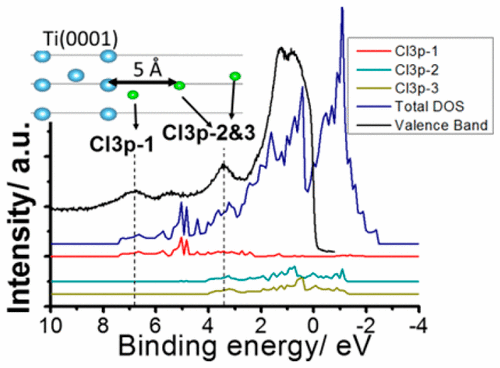当前位置:
X-MOL 学术
›
J. Phys. Chem. C
›
论文详情
Our official English website, www.x-mol.net, welcomes your feedback! (Note: you will need to create a separate account there.)
Catalytic Descriptors for the Design of Ziegler–Natta Catalysts Revealed by the Investigation of the Cl–Ti(0001) Interaction by Density of States Calculations
The Journal of Physical Chemistry C ( IF 3.7 ) Pub Date : 2017-09-20 00:00:00 , DOI: 10.1021/acs.jpcc.7b06980 Emmanouil Symianakis 1 , Stavros Karakalos 2 , Spyridon Ladas 3
The Journal of Physical Chemistry C ( IF 3.7 ) Pub Date : 2017-09-20 00:00:00 , DOI: 10.1021/acs.jpcc.7b06980 Emmanouil Symianakis 1 , Stavros Karakalos 2 , Spyridon Ladas 3
Affiliation

|
The deposition of MgCl2 on Ti(0001) followed by annealing above 450 °C has been previously reported to result in the desorption of the Mg atoms, the formation of a Cl/Ti(0001) interface, and a new contribution at binding energy (BE) 3.5 eV. We present density of states results from DFT calculations obtained for the Cl/Ti(0001) interface and compare them with reported spectra obtained by photoelectron spectroscopy with synchrotron radiation. Our results suggest that the new contribution at BE 3.5 eV is a Cl 3p peak originating from Cl atoms relaxing at long distances from the surface, whereas the Cl 3p peak at BE 7.0 eV should be attributed only to Cl atoms strongly adsorbed at either one of the hollow sites of the Ti(0001) surface. Our calculations also support an interpretation for published experimental observations on the valence band of TiCl4 adsorbed on a Au surface. The comparisons of DFT calculations with experimental results highlight significant features of the Ti–Cl interaction at distances longer than the usual Ti–Cl bond, the high sensitivity of the BE of Cl 3s and Cl 3p peaks to the distance between Ti and Cl, as well as the influence of the interaction of the Cl atom with the substrate on the Ti–Cl bond and consequently on the Ti–C bond which determines the olefin polymerization. These observations provide an explanation for many features of the Ziegler–Natta heterogeneous catalysts, identify two catalytic descriptors, Ti–Cl bond length and the BE of the Cl 3p peak, and provide the basis for the development of future Ziegler–Natta catalytic systems engineered at the atomic level.
中文翻译:

通过状态密度计算研究Cl-Ti(0001)相互作用揭示了Ziegler-Natta催化剂设计的催化描述符
MgCl 2的沉积先前已经报道过在Ti(0001)上进行退火,然后在450°C以上退火导致Mg原子的解吸,Cl / Ti(0001)界面的形成以及对结合能(BE)3.5 eV的新贡献。我们介绍了从Cl / Ti(0001)界面获得的DFT计算得出的态密度,并将其与通过同步加速器辐射的光电子能谱获得的报道光谱进行了比较。我们的结果表明,在BE 3.5 eV处的新贡献是一个Cl 3p峰,该Cl 3p峰起源于距表面很长距离的Cl原子,而在BE 7.0 eV处的Cl 3p峰应仅归因于在任一原子上强烈吸附的Cl原子。 Ti(0001)表面的空心位置。我们的计算也支持对TiCl价带的已发表实验观察的解释4吸附在Au表面上。DFT计算与实验结果的比较突出显示了在比通常的Ti-Cl键长的距离处Ti-Cl相互作用的显着特征,Cl 3s和Cl 3p峰的BE对Ti与Cl之间的距离的高灵敏度,因为以及Cl原子与底物之间的相互作用对Ti-Cl键的影响,并因此对决定烯烃聚合的Ti-C键的影响。这些观察结果解释了齐格勒-纳塔非均相催化剂的许多特征,确定了两个催化描述符,Ti-Cl键长和Cl 3p峰的BE,并为开发未来的齐格勒-纳塔催化体系提供了基础在原子水平上。
更新日期:2017-09-20
中文翻译:

通过状态密度计算研究Cl-Ti(0001)相互作用揭示了Ziegler-Natta催化剂设计的催化描述符
MgCl 2的沉积先前已经报道过在Ti(0001)上进行退火,然后在450°C以上退火导致Mg原子的解吸,Cl / Ti(0001)界面的形成以及对结合能(BE)3.5 eV的新贡献。我们介绍了从Cl / Ti(0001)界面获得的DFT计算得出的态密度,并将其与通过同步加速器辐射的光电子能谱获得的报道光谱进行了比较。我们的结果表明,在BE 3.5 eV处的新贡献是一个Cl 3p峰,该Cl 3p峰起源于距表面很长距离的Cl原子,而在BE 7.0 eV处的Cl 3p峰应仅归因于在任一原子上强烈吸附的Cl原子。 Ti(0001)表面的空心位置。我们的计算也支持对TiCl价带的已发表实验观察的解释4吸附在Au表面上。DFT计算与实验结果的比较突出显示了在比通常的Ti-Cl键长的距离处Ti-Cl相互作用的显着特征,Cl 3s和Cl 3p峰的BE对Ti与Cl之间的距离的高灵敏度,因为以及Cl原子与底物之间的相互作用对Ti-Cl键的影响,并因此对决定烯烃聚合的Ti-C键的影响。这些观察结果解释了齐格勒-纳塔非均相催化剂的许多特征,确定了两个催化描述符,Ti-Cl键长和Cl 3p峰的BE,并为开发未来的齐格勒-纳塔催化体系提供了基础在原子水平上。


























 京公网安备 11010802027423号
京公网安备 11010802027423号